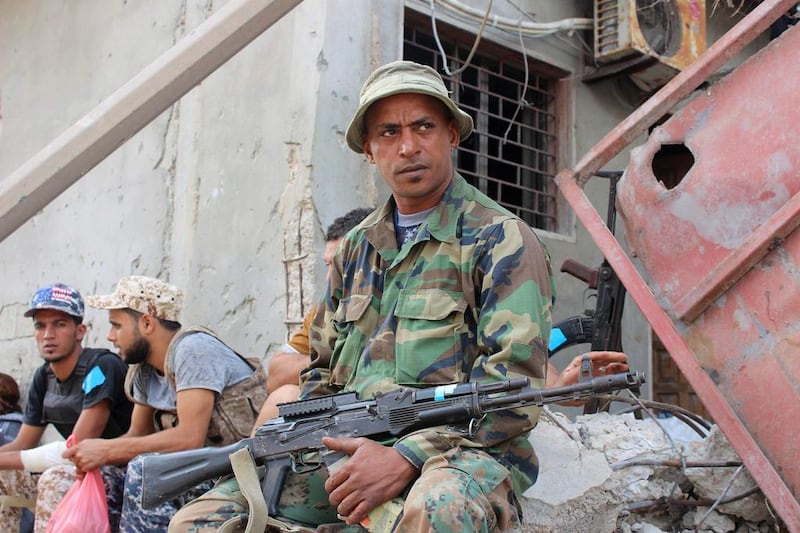SIRTE, LIBYA // After six months of heavy fighting, Libyan forces have advanced so deep into the strategic city of Sirte that they can pick out the Tunisian and Egyptian accents of their enemies from ISIL as they trade insults over the frontline.
Victory is imminent on this remote front of the war against ISIL, with the last few militants staging a last stand in a small area of just one square kilometre, US and Libyan officials say.
But the battle has been long and hard, and holds lessons for US backed forces trying to force the extremists out of the much larger Iraqi city of Mosul more than 2,500 km away.
“We faced unbelievable resistance. They won’t leave their posts even when houses are collapsing on them,” said Osama Issa, a 37-year-old businessman fighting with Libyan forces in Ghiza, the last neighbourhood of Sirte that ISIL holds.
“They know they will die anyway so they fight well.”
Defeat in Sirte will damage ISIL’s ability to show it is expanding globally and deprive it of a foothold outside Iraq and Syria. Losing Sirte and Mosul in quick succession would dent its morale and possibly its ability to recruit followers.
But the militants in Sirte have inflicted heavy losses on the Libyan fighters – at least 660 have been killed and 3,000 wounded – and held out longer than expected.
The battle has also underlined the importance of trapping fighters during battle because many have escaped from Sirte – with one Libyan commander putting the number at 400 – and are now staging attacks behind frontlines with increasingly sophisticated bombs.
Growing rivalry between the various factions in the Libyan forces also serves as a warning to the diverse groups fighting ISIL in Mosul: the end of the battle may bring political chaos and the risk of new military conflicts.
ISIL gradually took over Sirte from early 2015, taking advantage of the chaos in Libya since the start of a civil war in which long-time ruler Muammar Qaddafi was overthrown in 2011.
Sirte, Qaddafi’s former hometown, became its main base in North Africa. Like in Iraq and Syria, militant commanders began to impose their strict vision on Sirte, banning shisha pipe smoking and forcing women to wear robes.
Later, they enslaved migrant women, imposed taxes and meted out punishments such as public whippings and crucifixions.
Forces from the nearby city of Misrata, aligned with the UN-backed government in the capital Tripoli, started the military offensive to recapture Sirte in May after ISIL threatened their security.
Hiding among collapsed rooftops and in rubble-packed streets in Ghiza, the last extremists are holding out in the Ghiza neighbourhood of the Mediterranean port city.
The Libyan forces have been backed by hundreds of US air strikes and helicopter raids, and small teams of US and British military advisors. “We hear them at night shouting to us, telling us they are coming for us,” said Asruf El Qat, a student fighting in the rubble of Ghiza’s many collapsed villas. “It’s snipers, and landmines. We advance, they throw grenades. It’s a dirty war.”
Sniper fire crackled as Mr El Qat’s brigade kept watch though holes in walls, and occasional shells whistled overhead.
Another brigade armed with AK-47 assault rifles – some of them older men in uniform, others students in jeans and flip flop shoes – prepared to flush out a sniper holed up nearby.
ISIL leader Abu Bakr Al Baghdadi called this month for extremists to travel to Libya. It was not his first call for Libya recruits – Tunisians, Sudanese and Egyptian fighters fought in the city. But Sirte as a base is finished.
“Sirte was supposed to be a fallback from Iraq and Syria. That’s now gone,” said Geoff Porter at North Africa Risk Consulting. “Strategically, the Islamic State could point to Sirte and tell its followers that it really was global and growing. It can’t do that anymore.”
Misrata intelligence officials say there were once 2,500 militants in Sirte, the majority of them foreign extremists.
Sirte is now largely deserted. No life has returned to the outer districts of a city of 80,000 residents, where buildings are pockmarked with shell craters and bullet holes.
Few signs of ISIL’s rule remain. A large Libyan national flag now flies at the Zafaran roundabout, where militants once crucified victims. ISIL tax symbols are still spray-painted on shop walls.
The Libyan forces are mostly civilians who fought Qaddafi and returned to help against ISIL – students, mechanics and former army officers among them.
“Maybe it will take a week or two from what I can see now [to end Islamic State’s resistance in Sirte],” said Salah Al Houti, 22, a student fighting with the Libyan forces. “They stocked supplies and food underground.”
Libyan commanders say their advance has been slowed by casualties and a lack of ammunition, and complain they received none of the night vision equipment and other weaponry they asked for their allies to deal with snipers.
Fears about trapped civilians, at times used as hostages, have increased caution about air strikes and shelling.
“They [Islamic State] are using tunnels and using civilians as human shields,” Misrata intelligence chief Brigadier Mohamed Gnaidy said.
“They are professional fighters. Their objective is to kill as many of us as possible.”
* Reuters





